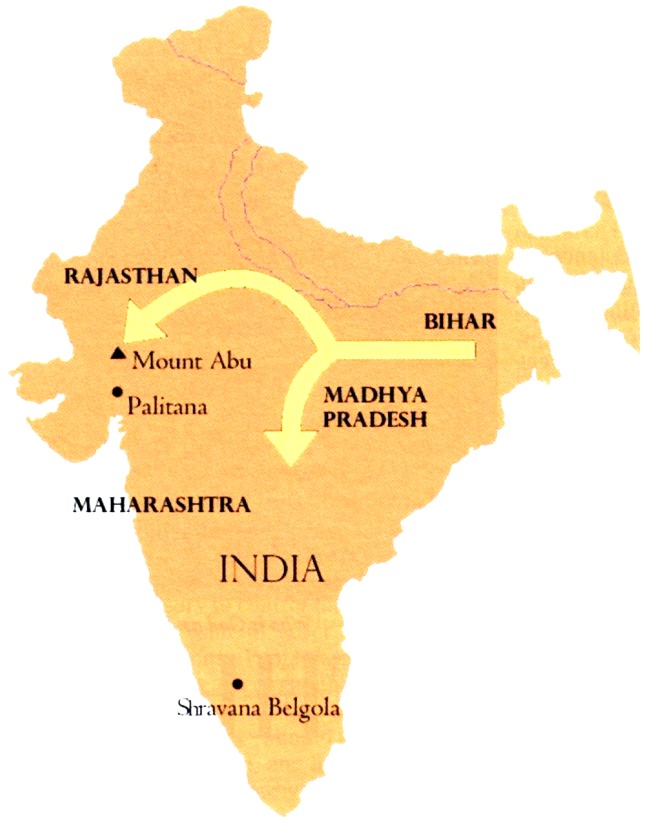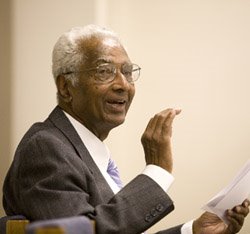Padmanabh S. Jaini traces the early history of Jainism, the formation of two different sects and their migration.
Mahavira was born in Kundalapura, in the state of Vaisali (North Bihar). However, his name is not mentioned in any Brahmanical texts. He was a senior contemporary of Gautama Buddha. His name, or the title Mahavira (Great Hero) by which he is now known, is not found in the Buddhist texts either. There he is referred to only by his clan name Nataputta. His parents (Siddhartha and Trisala) were followers of Parsva. When he was thirty years old, Vardhamana renounced the household and became a Nigantha (mendicant). After twelve years of severe ascetism, at the age of forty-two, he attained kevala-jnana (omniscience) and became a Jina (Tirthankara). He attained nirvana at the age of seventy-two at Pava, near modern Patna, in Bihar. At the time of his nirvana, his tirtha (the community of adherents) is said to have consisted of 14,000 monks, led by Gautama; 36,000 nuns, led by Candana; one hundred thousand sravakas and three hundred thousand sravikas (i.e. male and female householders who had assumed the rules of conduct appropriate to the follower of a Nigantha). The immediate successors to Mahavira are the two head teachers, Gautama and Sudharma, and the latter's disciple Jambu. They organized the teachings of Mahavira into twelve scriptures that were transmitted to the mendicant disciples in an oral tradition.
After some two hundred years, the hitherto unified mendicant order of Mahavira seems to break into two major groups. This event reportedly begins at Pataliputra (Patna, in Bihar) during the reign of the first Mauryan Emperor Chandragupta, a contemporary of Alexander the Great (c. 327 BC). The leader of the mendicant community at that time was Bhadrabahu (c.320 BC). Later accounts claim that during this period a council of monks was held in Patna in the absence of Bhadrabahu under the leadership of his disciple Sthulabhadra to collect the scriptures. This council reportedly resulted in a major split in the community of the Nigantha monks: one faction accepting the scriptures organized by Sthulabhadra and another rejecting his authenticity. The main point of controversy seems to pertain to wearing clothes: the followers of Bhadrabahu claiming that clothes are not permitted to a Nigantha monk, while those of Sthulabhadra maintaining that clothes are permitted to monks and do not constitute a parigmba (a piece of property). Eventually (i.e. toward the beginning of the Christian era) this dispute gave rise to the two main sects of Jain mendicants, the acekala (without clothes) and sacekala (with clothes). The subsequent history of Jainism is essentially a history of these two sects, called respectively, Digambara ('sky-clad' or naked monks), and Svetambara ('white-clothes-clad'mendicants). The lay devotees of these two sects are also identified by the same designation, i.e. Digambara and Svetambara. Both groups have spread far and wide in the vast land of India and have lived side by side for centuries with little interaction between them.

The migration of the Jain monks (together with their laity) took place along the two major trade routes of ancient India. In the east it went from Patna (in Bihar) to Orissa and then south to Andhrapradesh, Karnataka and Tamilnadu. The Digambaras claim that Bhadrabahu and his followers followed this route and established their mendicant orders in these distant places. The first inscriptional evidence for such a migration is provided by the Jain king Kharavela, who ruled around 150 BC, from Udayagiri, near the modern city of Bhuvaneshvara in Orissa. The route to the west went parallel to the river Ganges and terminated in Mathura (near modern Agra), on the banks of the Yamuna. A large scale of migration of Jains (and Buddhists) took place along this route after the fall of the Ashokan Empire (in 150 BC). Henceforth Jains almost disappeared from Magadha, the land of Mahavira, but prospered greatly in Mathura. Excavations in Mathura have yielded a large number of Jain monuments and inscriptions (c.150BC to 500AD), and stone images of Tirthankaras attended by monks, nuns and lay devotees.
From Mathura the Jains of both sects made rapid progress toward the south, to Rajasthan and Malwa, and by the second century they were well established at Valabhi, the capital city of Saurashtra (near modern Junagadh). Here the Digambara teachers, Puspadanta and Bhutabali, are reported to have compiled the remnants of their scriptures called the Sat-khanda-ajjama (in 150 AD) received from their teacher Dharasena, of the lineage of Acharya Bhadrabahu. Valabhi was also the city where the entire scripture (Agama) of the Svetambara tradition was reorganized and written down (on palm leaves) under the supervision of Acharya Devarddhigani Ksamasramana in the year 453AD. We owe this date to the Kalpasutra, a Svetambara text about the 'Lives of the Jinas' (Jinacaritra), which states: 'After his [Mahavira's] Nirvana nine centuries have now elapsed; of the tenth century this is the eighth year'. The year 980 of the Vira-nirvana-samvat - the earliest historical era of India - recorded here helps us to establish dates of Mahavira as 599-527 BC.
The Digambaras have settled in large numbers in great many cities of Rajasthan, Malwa and Gujarat, but their literary activities flourished more in the south. They did not accept the legitimacy of the canon recognized by the Svetambaras, and needed to produce a scripture of their own. This need was fulfilled by Acharya Kundakunda (c. 150-200 AD, probably from Andhra) of the Bhadrabahu Uncage. Kundakunda composed several important short texts (in Prakrit) described as the 'Essence' (sara): the Samayasara (The Essence of Self-Realization), the Pravacanasara (The Essence of the Teaching) and so forth.
Acharya Umasvami(c. 200 AD) produced a most systematized summary of the entire doctrine in the work called Tattvarthasutra. In addition to the voluminous commentaries to the works mentioned above, eminent authors like Samantabhadra (5th century), Akalanka (7th century), and Virasena (8th century) also mention here the Mahapurana by Jinasena(770-850 AD, completed by his disciple Gunabhadra), the main source of the Digambara narratives about twenty-four Jinas and other illustrious figures of the Jain faith. Jinasena was also influential in the court of the Rashtrakuta kings(800-900 AD). During this time several magnificent Jain caves were excavated in the hills of Ellora (near Aurangabad in Maharashtra). During the same period a Jain, named Jinadattaraya, carved out a small kingdom at a place now known as Humca where he built great temples in honour of the Jinas and established a shrine sacred to the goddess Padmavati, a guardian deity of Parsva. But the most glorious achievement of the Jains of Karnataka was the erection of the colossal image of Bahubali on the mountain top of Shravana Belgola. This image was commissioned by Camundaraya, who was a prominent Jain general in the Ganga Kingdom, in 948AD, at the instruction of Acharya Nemicandra. Shravana Belgola also served as a major centre for libraries (bhandaras) supervised by the line of bhattarakas (teachers and administrators in charge) beginning with Panditadeva (1398 AD), and remains to this day a major place of Jain pilgrimage.
Padmamabh S. Jaini is a former Professor of Religions at University of California, Berkeley.
 Padmanabh S. Jaini
Padmanabh S. Jaini
